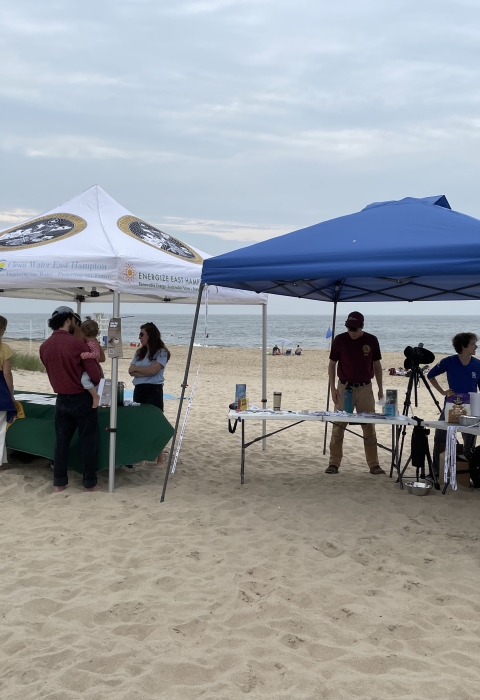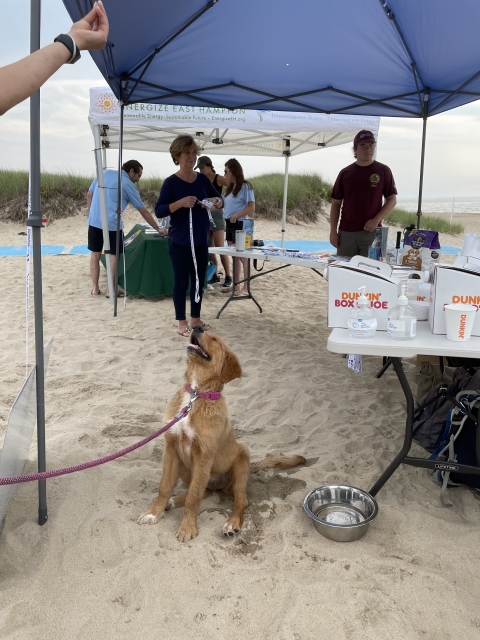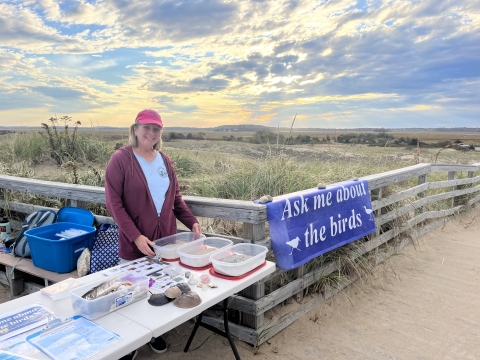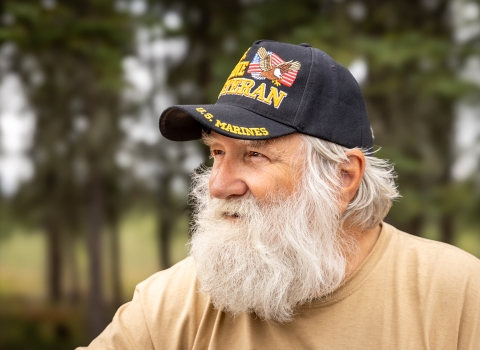For many, time at the beach is about rest and relaxation, perhaps with a four-legged friend. For shorebirds, however, the beach is serious business. Whether raising a family in the summer or refueling during migration, birds like the piping plover need their space.
That’s why the U.S. Fish and Wildlife Service and our partners in the Atlantic Flyway Shorebird Initiative used social science — the study of people and relationships — to create an innovative approach to addressing beachgoer behavior.
Our rec room is their whole house
Shorebirds travel up and down the Atlantic Flyway — the migration route that stretches from Canada, along the East Coast, to the tip of South America. They need beaches to rest and refuel along the way and to nest and raise chicks when they reach their breeding grounds.
Threats linked to humans are everywhere. Sea level rise and more frequent severe storms caused by climate change climate change
Climate change includes both global warming driven by human-induced emissions of greenhouse gases and the resulting large-scale shifts in weather patterns. Though there have been previous periods of climatic change, since the mid-20th century humans have had an unprecedented impact on Earth's climate system and caused change on a global scale.
Learn more about climate change are eating away at their beach habitats. Human development is creeping in, bringing predators like foxes, raccoons, gulls and rats that are adept at living with people.
Some dangers are more direct: Beach-walking and dog-walking can make shorebirds fly off, leaving food, nests and chicks behind and wasting precious energy. In the worst-case scenario, people and dogs destroy nests and kill chicks.
To meet the needs of wildlife and people, the Atlantic Flyway Shorebird Initiative — a partnership of public and private groups throughout the Western Hemisphere — created a multi-faceted approach to managing human disturbance to shorebirds that engages communities in conservation actions. Based in social science, it’s an innovative, effective tool for modifying beachgoers’ behavior.
Breakfast at the beach
On a sultry July morning at Atlantic Avenue Beach in Amagansett, New York, people and their pets enjoyed free baked goods and casual conversation. The “Dogs and Donuts” event at the eastern tip of Long Island was about more than socializing and snacking, though. Its goal was protecting nearby nesting shorebirds.
Dogs are allowed at the town-owned beach before 10 a.m. and after 6 p.m. They need to be “under control” but not necessarily leashed. Some visitors are reluctant to leash their dogs, believing the pets won't harm shorebirds. But even the best-behaved canine can startle nesting birds and crush fragile eggs.
Right next door is Amagansett National Wildlife Refuge. To protect beach-nesting birds like piping plovers and least terns, dogs aren’t allowed on the refuge. Posting the refuge boundary is futile, however, as signs are quickly washed away with the tide.
Visitors walking their dogs at Atlantic Avenue Beach often unknowingly continue onto refuge land. Many locals don't know the refuge exists.
Refuge Manager Annji Bagozzi turned to the community to address dogwalkers’ behavior at the refuge, meeting with town representatives to discuss connecting with visitors using the novel approach. With help from refuge interns and town staff, a breakfast event was planned at Atlantic Avenue Beach to encourage owners to leash their dogs at all times.
In addition to treats for pooches and their people, event staff handed out refuge-branded leashes, piping plover “chick magnets” for cars, shorebird temporary tattoos and information about nesting shorebirds.
“This was a social experiment,” Bagozzi said. “Because there’s no rule at the town beach to keep pets on leashes, we’re swimming against the tide, but we hope any behavior change will carry over to refuge property.”
The event attracted 46 beachgoers, most with their canine companions. Interactions were overwhelmingly positive, and many people were eager to learn more about the refuge and its role helping nesting shorebirds. Most of the visitors who arrived with their dogs off leash walked away with them tethered.
Ensuring autumn access
At Parker River National Wildlife Refuge, north of Boston, nesting shorebirds are given all the space they need. Dogs aren’t allowed, and beginning April 1, most of the beach is closed to visitors, while piping plovers and least terns lay eggs and raise chicks.
Volunteer shorebird stewards sit near the boundaries to educate visitors about the birds and encourage compliance with closed areas. Come fall, visitors are eager to return to the beach after four months away.
But the beach’s value to shorebirds doesn’t end when summer does. In fact, just as plover and tern chicks are fledging, semipalmated sandpipers, semipalmated plovers and red knots arrive from the north on their fall migration.
Migration is the most vulnerable time of year for many birds, when they need places to rest and fuel up for their flight south. A fall beach closure wouldn’t fly with visitors, however, so shorebirds and people must share.
Madelyn Kaplin, the refuge’s shorebird outreach and biological technician, teaches visitors about shorebirds’ needs and the importance of stopover sites during fall migration. She also trains volunteers to interact with beach walkers in the fall.
Kaplin watched interactions between visitors and south-bound shorebirds and used the new tool to reduce disturbance to the birds. She chose specific positive messages — like “walk around the flock” — that are easy for the public to understand and follow.
Nancy Pau, refuge wildlife biologist, is pleased with the results.
“We have touched the hearts and minds of some of our beach visitors, and they will give shorebirds space even when staff and volunteers aren’t out there,” she said. “That will have long-lasting impacts, especially if they educate their friends.”
In an ideal world, there would be enough beach for everyone, all the time. But in one of limited resources, we need to protect shorebirds from disturbance by people and dogs. This new social-science approach is showing results and making co-existence possible ... and sometimes it comes with donuts.







